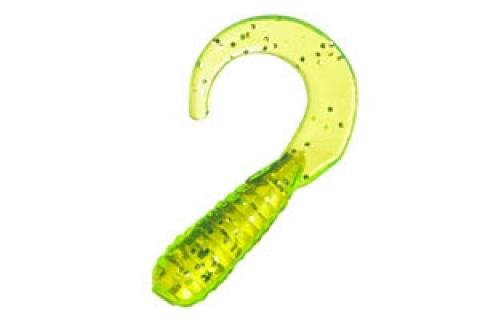
As a change of pace, my friend Tom Ference and I fished a medium-sized creek over the Fourth of July weekend. Not only did we avoid the holiday congestion of nearby lakes, we enjoyed quality fishing for smallmouth bass. And I was reminded of an offering often overlooked by anglers, myself included: the use of the standard twister tail grub as a swimbait.
 |
| Grubs with a ribbed body, like the Bass Pro Shops Squirmin' Grub, are ideal for tossing. |
Nearly every angler that fishes for bass or walleyes carries a bag or two of twister tails. They see use, perhaps regular use, but nearly always in the capacity of a bottom bouncing jig. While they function great in that role, they can do more.
The stream Tom and I fished is one of which I'm quite familiar. It's a typical western Pennsylvania warm water creek, averaging perhaps 100 feet wide. It holds a good population of smallmouth bass, along with the occasional muskie and northern pike. Largemouth bass show up, likely fish that move upstream at times from an impounded section. Small crankbaits work well there, as do minnow-shaped baits and jerkbaits. So "volunteers" from this selection of lures saw the water first during our recent foray. When they all came up fishless, I rigged up a 3-inch twister tail on a quarter-ounce jig head, made a cast into a deep, rock-lined pool along the far bank, and began a steady retrieve. As the bait neared a submerged boulder, a 16-inch smallie intercepted it. Several others succumbed to the swimming grub during the balance of the outing.
How to Fish a Swimming Grub
There's nothing fancy about fishing a swimming grub. Typically I've found a straight retrieve, one easy to track by the fish, to be most productive. This is especially true in slightly stained water (as opposed to clear water). Grubs with a ribbed body, like Bass Pro Shops Squirmin' Grub, are ideal, as the ribs move a bit of water, possibly giving off subtle bass-attracting vibrations. A simple lead head jig like Bass Pro Shops Painted Jighead couples fine with the grub. I find 1/8 and 1/4 ounce lead heads to be most appropriate for swimming grub use.
How to Rig a Swimming Grub
Perhaps the most important aspect is in the rigging. They need to be rigged straight. I don't think it makes a big difference if you rig them with the sickle tail up or down, but for the best action, it is important that the fishing hook be centered. The grub will have a slight ridge along both the top and bottom of its body, from the manufacturing process. Use this line as a guide when threading the jig hook through the bait, so everything is lined up well; i.e. when you pop the point of the hook, back out of the grub body — it should be right on this line.
As the bait gets torn up from bass bites, neatly trim off about a quarter inch of the grub's head and re-rig it. You'll be able to catch some bonus fish on it.
- 11651 views

